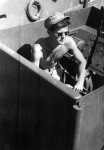An encounter with Kennedy, PT-109 repaired by McCook veteran

McCOOK, Nebraska -- Before we shared his amazing experiences in last year's Military Salute section, many of Billy Loop's family members were familiar with only one of his World War II tales. The emotion that overcame him when he recollected the sorrow-filled experiences is likely to blame, making his years of silence very easy to understand.
The one story he had shared, though, his "claim to fame" as he referred to it with a chuckle, is when he met a young sailor by the name of John F. Kennedy.
While Loop was assigned to LST-448, the ship spent several months operating out of Townsville, Australia. Loop recalls that the Allied forces believed Japan wanted to take Australia and were afraid they were already on their way, "so they tried to head them off," said Loop.
His ship worked its way from island to island, starting with a little spy island they called "Meadowlark island," then on to New Guinea for two months and eventually Guadalcanal.
"We first arrived in Guadacanal in about July 1943. The PT (Patrol Torpedo) boats were coming in there about the same time. They were building a base for the PT boats on Rendova Island," said Loop. The base wasn't completed yet so ships such as Loop's LST were supplying the construction crews.
The PT boats were small and designed to go in real fast, drop torpedos and get out, Loop said. "There were only about eight guys on the PT boats, it was so crowded, more crowded than submarines. That's why they had to have a base to operate out of; they couldn't stay on there for very long," said Loop.
Loop believes there was a connection between the personnel officer on his ship, LST-448, and the commander of PT-109, Lieutenant John F. Kennedy. "We had our personnel officer on our ship that was from Massachusetts, that I think knew Kennedy prior, maybe that's the reason they came. I just got a hunch that's right," said Loop.
"When the 109 tied up beside us, the skipper (Kennedy) went right to our officer's stateroom and stayed there. The officer come out and down to the electric shop and wanted to know if I would look at their PT boat, he said it was hard to start. I went down and looked at it, it had a bad battery cable, so I made a new battery cable for 'em and put it on," said Loop.
Loop says the reason he remembered it was 109 was because they had a log book they tracked materials they used in and he remembers writing down 109. "109 didn't mean anything to me then, because I didn't know Kennedy and I didn't know who it was," said Loop.
When Kennedy ran for president he looked so different from the young man that Loop remembered that he was convinced he must been wrong on the boat number. "I said that's not the guy I knew, I'm wrong on that. Then the movie come out, PT-109. In that movie he looked just like I remembered him when he came onboard our ship. So I figured it out a long time afterwards that it was President Kennedy," said Loop.
Loop just saw Kennedy briefly, when he exited the officer's stateroom and thanked Loop for fixing the battery cable on PT-109, but he remembers he looked vastly different from the President Kennedy the world knew. "He didn't look anything like it, he was so full faced and everything when he became president and when I seen him he was real thin and he looked a lot younger, of course," said Loop.
"As we progressed up through the islands we bypassed an island called Kolombangara Island - we called it Kolombangara straights. We had to go through there at night because they had guns up in the hills that would fire on the ships that tried to come through there," said Loop. He explained that Japanese soldiers occupied Kolombangara and allied forces had decided to bypass them, taking the other islands around them and leaving them stranded, cut off from supply lines.
"I thought that is where PT-109 was hit by another boat and sunk, but it turned out it was at Vella Lavella, where my ship was also sunk," said Loop.
PT-109 was run down by a Japanese destroyer, Aug. 2, 1943. Billy Loop's ship, LST-448, was sunk after it was hit by a bomb dropped from a Japanese fighter plane, Oct. 1, 1943, off the coast of Vella Lavella.
